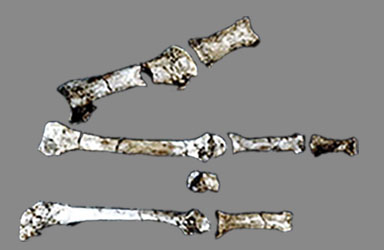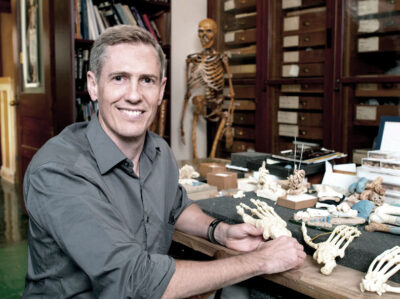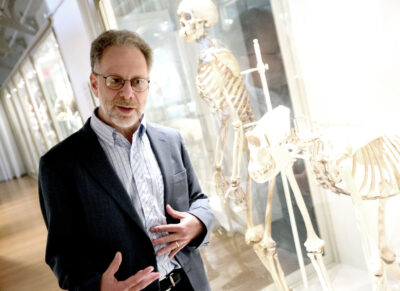 The sequence of biological events leading to hominin locomotion has long intrigued evolution scientists.
The sequence of biological events leading to hominin locomotion has long intrigued evolution scientists.
Last week, the journal of Nature reported on a hominin-like foot discovered in Eastern Africa. Entitled “A new hominin foot from Ethiopia shows multiple Pliocene bipedal adaptations,” the finding draws into question the evolution of hominin locomotion.
Yohannes Haile-Selassie (pictured right below) of the Cleveland Museum of Natural History led the research team in the Woranso-Mille area of the Afar Triangle region of Ethiopia, known as Burtele. In this region, in 1974, Donald Johanson, and his graduate student Tom Gray, discovered Lucy. The fossilized foot bones, however, unexpectedly differ significantly from those of Lucy, also known as Australopithecus afarensis.
“Lucy” acquired her name from the song “Lucy in the Sky with Diamonds” by the Beatles – both becoming big hits. The research team expected to unearth fossils similar to Lucy’s. As Haile-Selassie explains –
“Here we show that new pedal elements, dated to about 3.4 million years ago, belong to a species that does not match the contemporaneous Australopithecus afarensis.”
Erin Wayman (pictured left below), writing for the Smithsonian Magazine in the article entitled “New Hominid Fossil Foot Belonged to Lucy’s Neighbor,” notes –
“Lucy wasn’t alone… But while Lucy spent most of her time on the ground, the newly discovered species were more adept at moving around in the trees.
ScienceDaily, in the article entitled “Newly discovered foot points to a new kid on the hominin block,” concurs –
“It seems that ‘Lucy’ was not the only hominin on the block in northern Africa about 3 million years ago.”
Opposable Toe
 The difference is an “opposable big toe bone.” The big toe may be a clue into the evolution of hominin locomotion by means of natural selection. As Naomi Levin (pictured right) , of the Johns Hopkins University and co-author, explains to ScienceDaily –
The difference is an “opposable big toe bone.” The big toe may be a clue into the evolution of hominin locomotion by means of natural selection. As Naomi Levin (pictured right) , of the Johns Hopkins University and co-author, explains to ScienceDaily –
“Although it was found in a neighboring project area that is relatively close to the Lucy fossil site, it does not look like an A. afarensis foot.”
Burtele, the common name given to this new finding, has bones that are indicative of walking, such as certain joints allowing the toes to push off the ground and propel the foot forward  during upright walking. However, as Wayman notes –
during upright walking. However, as Wayman notes –
“But the foot also appears apelike: Its opposable, grasping big toe suggests the unnamed species was a good tree climber and probably spent much less time on the ground than Lucy and later hominids.”
While anticipating to shed more light on the evolution of hominin locomotion, just the opposite happened. As Levin explained to ScienceDaily –
“This fossil makes the story of locomotion more complex, and it shows that we have a lot more to learn about how humans transitioned from moving around in trees to moving around on the ground — on two legs.”
 Brian Richmond (pictured left), a paleoanthropologist at Smithsonian’s Human Origins Program, in an interview with Wayman, explains the implications –
Brian Richmond (pictured left), a paleoanthropologist at Smithsonian’s Human Origins Program, in an interview with Wayman, explains the implications –
“This find alters our understanding of the evolution of bipedalism because it shows that there was more diversity than previously recognized in the ways that early moved around their environments.”
New Species?
Is Burtele a new species? According to Haile-Selassie, in an interview with the National Science Foundation (NSF), the answer is yes –
“There was indeed more than one early hominin species during that time,”
 Timothy White (pictured right), a paleontologist at the University of California, Berkeley, disagrees with Haile-Selassie. As noted in the PhysOrg article entitled “’Lucy’ lived among close cousins: Discovery of foot fossil confirms two human ancestor species co-existed,” –
Timothy White (pictured right), a paleontologist at the University of California, Berkeley, disagrees with Haile-Selassie. As noted in the PhysOrg article entitled “’Lucy’ lived among close cousins: Discovery of foot fossil confirms two human ancestor species co-existed,” –
“Tim White (a member of the research team who began uncovering Lucy in 1973) argued… the subtle differences between the two could be subsumed into an intra-specific variation.”
Carolyn Ehardt (pictured left), NSF Biological Anthropology Director, in the article “Burtele Foot Indicates Lucy Not Alone,” underscores the dilemma –
“We become increasingly aware of the fact that the evolutionary history of hominins is not unlike that of other groups of organisms in the potential for morphological and behavioral diversity and multiple adaptive pathways characterizing those life forms during particular evolutionary time periods.”
The NSF article continues highlighting the specific issues facing the evolution of hominin locomotion dilemma –
“The Burtele foot has some skeletal ratios that fall within the human and gorilla distribution, but outside those of chimpanzees. In addition, the metatarsal of the fourth toe is longer than that of the second toe, a condition seen in some monkeys and Miocene apes.”
In the ScienceDaily article “’Lucy’ lived among close cousins: Discovery of foot fossil confirms two human ancestor species co-existed,” Bruce Latimer of Case Western Reserve University said, “This discovery was quite shocking.”
“These fossil elements represent bones we’ve never seen before. While the grasping big toe could move from side to side, there was no expansion on top of the joint that would allow for an expanded range of movement required for pushing off the ground for upright walking.”
 Daniel Lieberman (pictured right), an evolutionary biologist at Harvard University, in the article “How did humans evolve to walk upright? Fossil record discovery complicates the picture,” as candidly explained by journalist Nora Doyle-Burr –
Daniel Lieberman (pictured right), an evolutionary biologist at Harvard University, in the article “How did humans evolve to walk upright? Fossil record discovery complicates the picture,” as candidly explained by journalist Nora Doyle-Burr –
“We need more fossils to determine what sorts of bodies went with these feet.”
Haile-Selassie summarizes his team’s study findings –
“Although the taxonomic affinity of BRT-VP-2/73 is currently indeterminate, there is adequate morphological evidence that it does not belong to the contemporaneous species, Au. afarensis. Regardless of its taxonomic affinity, however, this specimen is the first strong evidence indicating multiple hominin lineages, adaptively separated (at least in the foot skeleton), in the 3–4-Myr-ago time interval. A final but important note for the metatarsal ratios used in the PCA performed in this study, anatomically modern humans and gorillas overlap substantially, and BRT-VP-2/73 falls in the gorilla cluster. It is unclear at this point what the functional implications of this overlap might mean; it requires further investigation as it has important consequences for the interpretation of locomotor behavior in early hominins.”
Hominin Locomotion Challenges
Even though Homo sapiens is the most widely studied species in the history of civilization, developing a scientific consensus on even ten transitional links has been the Black Hole of the evolution industry since Charles Darwin published The Origin of Species in 1859. In the twenty-first century, evolution scientists cannot develop a consensus on the evolution of hominin locomotion.
Francis Clark Howell, a physical anthropologist at the University of California, Berkeley in 1996 summarized the long-standing problem with human evolution theories –
“There is no encompassing theory of [human] evolution…. Alas, there never really has been.”
Ann Gibbons, a correspondent for the Science Magazine, opined –
“The story of human evolution has lately become as complicated as a Tolstoy novel.”
Henry Gee, the chief science writer for Nature, agrees –
“Hominid evolution—[is] as mysterious as ever.”
Darwin’s dilemma intensifies.
Genesis
The evolution of the hominin locomotion saga, rather than fitting in as a critical missing piece of the human evolution puzzle, only compounds the problem. Evidence from Burtele, however, is compatible with the Genesis account written by Moses.
During the Scientific Revolution, in the words of Blaise Pascal, a French mathematician and physicist noted for developing the laws of pressure and vacuum –
“The greatest single distinguishing feature of the omnipotence of God is that our imagination gets lost when thinking about it.”
Refer to the Glossary for the definition of terms and to Understanding Evolution to gain insights into understanding evolution.
2020 Update
What is known as “Burtele” has yet to receive a scientific classification.
Biological classification is a critical component of the taxonomic process. As a result, it informs the user as to what the relatives of the taxon are hypothesized to be. Biological classification uses taxonomic ranks, including among others (in order from most inclusive to least inclusive): Domain, Kingdom, Phylum, Class, Order, Family, Genus, Species, and Strain.
Johan Nygren, an independent researcher in Stockholm, Sweden, published the article “Hominin Evolution Was Caused by Introgression from Gorilla” in the open-access journal Scientific Research. Nygren suggests –
“It can be predicted that Paranthropus and Australopithecus, like Pan and Homo, diverged through lineage sorting as the two lineages co-opted genes from the Gorilla lineage to adapt for separate niches.”
WIKIPEDIA
A search for “Burtele” in WIKIPEDIA only returns – “The page “Burtele” does not exist.”
The Paranthropus page states –
“Paranthropus is a contested genus of extinct hominins, sometimes referred to as the robust australopithecines, which lived between approximately 2.6 and 0.6 million years ago (mya) from the end of the Pliocene to the Middle Pleistocene. There are two widely accepted species: P. robustus and P. boisei; however, Paranthropus is sometimes considered to be invalid and synonymous with Australopithecus.”
Evolution 101
A search for “Burtele” in Evolution 101 only returns – “No Results.”
Smithsonian Institute – Human Evolution Genetics
A search for Burtele in Smithsonian only returns – “Showing results 1 – 0 for Burtele.”
Harvard University – Department of Human Evolutionary Biology
A search for Burtele in the Department of Human Evolutionary Biology – “Search found 0 items”


